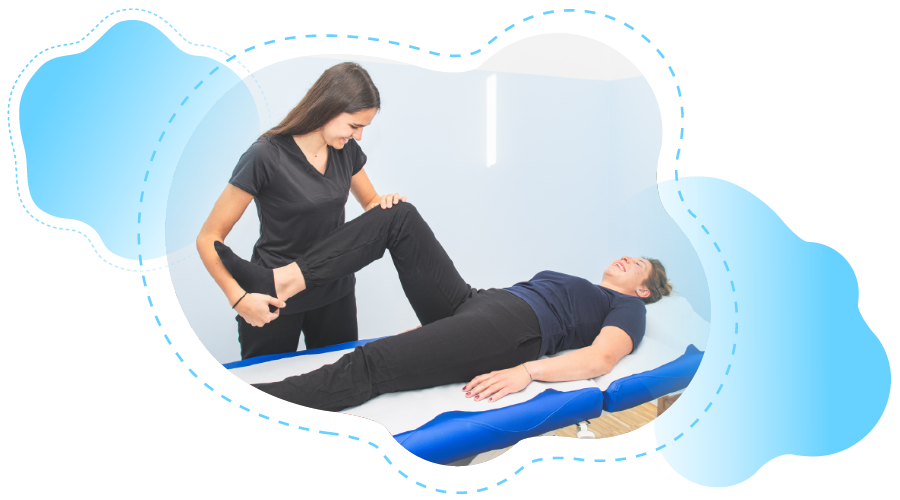Illness and injury are not uncommon in Australia. In fact, approximately 1 in 2 people report having a chronic condition, defined as a long-term persistent health concern [1]. Unfortunately, as we age the prevalence of these chronic conditions increases. Around 1 in 2 people over the age of 65 years report having 2 or more chronic conditions, and women are more likely to report multiple chronic conditions than men (23 vs 18%) (1).

According to the Australian Institute of Health and Welfare, the five most frequently reported chronic conditions by women in Australia are arthritis and back problems, osteoporosis, asthma and mental health-related concerns. Additionally, coronary heart disease, dementia and chronic obstructive pulmonary disease (COPD) are specific long-term health concerns that largely contribute to the burden of disease in Australia; that is, these conditions largely contribute to fewer years of life lived in full health (2).
Living with chronic conditions can be challenging. Many people also experience chronic pain which can deter them from participating in activities that they’ve previously enjoyed – including being active. It’s important to note that chronic pain can be a protective mechanism used by your body, and perceptions of pain are different for everyone and may vary according to circumstances. Dissimilar to acute pain, like when you jammed your finger in the door, chronic pain is not necessarily a sign that you are doing damage to your body. If you have persistent/chronic pain, start a conversation with your GP or treating health care professional about your options, including physical activity.
In addition to chronic conditions, new and existing injuries can be debilitating, and cause varying degrees of physical disability. In Australia, falls are a common cause of injury hospitalisation (3), and when considered in the context of the high prevalence of osteoporosis among older women (4, 5) and declines in muscle mass associated with ageing (6), the resulting short- and long-term disability can be challenging to overcome.
Although illness and injury are unfortunately quite common, there are treatments available to help – what if I told you that there was a common treatment that could address many of these concerns? Have you thought about movement as medicine?
“The beneficial health effects of physical activity or movement are well documented, and even small amounts of physical activity or movement can have a tremendous positive effect on our health and wellbeing (7).”
While the notion that ‘Exercise is Medicine’ has been adopted worldwide (8), exercise is a structured, pre-planned activity that may seem out of reach for some people during and/or after illness or injury. However, given even small amounts of movement is beneficial, reframing ‘movement as medicine’ may help us prioritise moving more in our daily schedules.
So, what are the benefits of moving more?
Physically moving our bodies increases our heart rate and blood flow, strengthening the heart and providing numerous cardiovascular benefits while delivering vital nutrients and oxygen to our muscles and joints. This same movement may also improve symptoms of chronic lower back pain (9) and knee and hip osteoarthritis (10). Furthermore, physically moving our body mass can help to improve our balance to reduce the risk of falls, while strengthening our muscles, and slowing the rate of strength loss with ageing (12). Plus, certain load-bearing activity has been shown to considerably improve bone mineral density in women (13), reducing the risk of fractures in the event of a fall.
These are just some of the ‘physical’ benefits of being physically active – but this same medicine can also positively impact our psychological and social wellbeing! For example, there is strong evidence that physical activity has beneficial effects on the physical and mental wellbeing of peoples with a wide-range of mental-health concerns (14). Collectively, in some form or another, physical activity can provide wide-reaching health-related benefits for women in Australia.
Given it’s clear that movement is medicine, let’s try to take some every day! Although 10,000 steps a day might be a long-term goal for some, starting with a smaller goal is more achievable, particularly around pre-existing commitments. Indeed, research examining the experiences of women has clearly articulated barriers to planned exercise, including time-related barriers, family duties, and lack of social support, to name a few (15).
Where do we start?
Building movement into our daily routines, in the context of our family commitments, is a great place to start. Can you walk the kids to school, or park further away than usual and walk the rest? Can you take the stairs instead of the elevator, take a walk during your lunch break with colleagues, or walk with your friends during/after your mid-morning coffee? Don’t underestimate the social benefits of group activity! Tying movement to an existing habit can also be an effective strategy to increase your daily movement!
The next step after starting out slowly and adding more movement to our day, is to progressively increase the amount of movement we do over time. This can be achieved in several ways, but one strategy is to increase the amount of movement completed in a single instance. For example, increasing the number of steps taken, or time being active – you might walk only a few minutes to start with, but you can gradually increase the duration over time! Maybe it’s progressively parking a little further away from our destination, to increase incidental activity. Another key principle is frequency; although it may be initially challenging to increase your movement every day, slowly increasing the number of days you prioritise movement can be beneficial. In addition, different types of movement can be stimulating and motivate us to be active! Although it’s more of a planned activity, low-impact water-based activity is a fantastic option for people getting back into movement after injury or illness, particularly for people experiencing chronic pain and movement restrictions. The more of your body that’s in the water, the freer you will feel! Progressively reducing the amount of your body that is submerged is a great strategy to challenge yourself over time.
If you’re returning to physical activity following injury or illness, remember, movement is medicine! Physical activity guidelines in Australia recommend accruing at least 150 minutes of moderate-intensity physical activity every week [16], but you can progressively increase your amount to that level.
To summarise, physical activity is an evidence-based approach to improve your health. If you’re returning to physical activity following injury or illness:
- Start slowly and build movement into your everyday routines.
- Progressively increase the amount and frequency of your physical activity.
- Incorporate different types of movement for variety, and to improve muscle and bone strength
- Every Move Matters!
These are general tips, tricks and principles to get you moving, and started on your journey to a healthier you. If you haven’t been active in a while, speak with your GP, and ask to see an Accredited Exercise Physiologist for a specific prescription to suit you.
About the author
Dr. Thomas Doering is a Senior Lecturer in Health Sciences at CQUniversity. Tom is currently the Head of Course for the Bachelor of Allied Health, and an Exercise and Sport Science Australia Accredited Exercise Physiologist. As an Accredited Exercise Physiologist (AEP), Tom previously worked in clinical practice with specific interest in musculoskeletal rehabilitation to help people recover from injuries and illness. Tom’s research investigates the mechanisms underpinning muscle growth and loss, of vital importance to the rehabilitation process.

References:
- Australian Institute of Health and Welfare, Chronic conditions and multimorbidity. 2022, AIHW, Australian Government.
- Health, A.I.o. and Welfare, Australian Burden of Disease Study 2022. 2022, AIHW: Canberra.
- Australian Institute of Health and Welfare, Falls. 2022, AIHW: Canberra.
- Health, A.I.o. and Welfare, Estimating the prevalence of osteoporosis in Australia. 2014, AIHW: Canberra.
- Salari, N., et al., The global prevalence of osteoporosis in the world: a comprehensive systematic review and meta-analysis. Journal of Orthopaedic Surgery and Research, 2021. 16(1): p. 609.
- Cruz-Jentoft, A.J., et al., Prevalence of and interventions for sarcopenia in ageing adults: a systematic review. Report of the International Sarcopenia Initiative (EWGSOP and IWGS). Age Ageing, 2014. 43(6): p. 748-59.
- Warburton, D.E.R. and S.S.D. Bredin, Health benefits of physical activity: a systematic review of current systematic reviews. Curr Opin Cardiol, 2017. 32(5): p. 541-556.
- American College of Sports Medicine. Exercise is Medicine. n.d.; Available from: https://www.exerciseismedicine.org.
- Hayden, J.A., et al., Exercise therapy for chronic low back pain. Cochrane Database Syst Rev, 2021. 9(9): p. Cd009790.
- Goh, S.L., et al., Efficacy and potential determinants of exercise therapy in knee and hip osteoarthritis: A systematic review and meta-analysis. Ann Phys Rehabil Med, 2019. 62(5): p. 356-365.
- Lang, J.E., The impact of exercise on asthma. Current Opinion in Allergy and Clinical Immunology, 2019. 19(2): p. 118-125.
- Bao, W., et al., Exercise Programs for Muscle Mass, Muscle Strength and Physical Performance in Older Adults with Sarcopenia: A Systematic Review and Meta-Analysis. Aging Dis, 2020. 11(4): p. 863-873.
- Kistler-Fischbacher, M., B.K. Weeks, and B.R. Beck, The effect of exercise intensity on bone in postmenopausal women (part 2): A meta-analysis. Bone, 2021. 143: p. 115697.
- Schuch, F.B. and D. Vancampfort, Physical activity, exercise, and mental disorders: it is time to move on. Trends Psychiatry Psychother, 2021. 43(3): p. 177-184.
- Peng, B., J.Y.Y. Ng, and A.S. Ha, Barriers and facilitators to physical activity for young adult women: a systematic review and thematic synthesis of qualitative literature. International Journal of Behavioral Nutrition and Physical Activity, 2023. 20(1): p. 23.
- Australian Government, Australia’s Physical Activity and Sedentary Behaviour Guidelines, Department of Health, Editor. 2021.
The Activate Your Everyday Series is proudly supported by the Queensland Government and Health and Wellbeing Queensland through ActiveKIT Round 2
